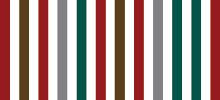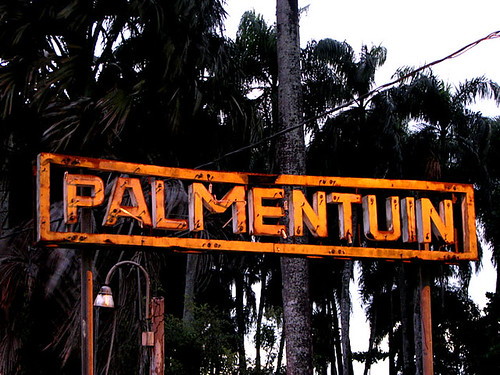
On Kleine Waterstraat, at dusk. Photo by Nicholas Laughlin; 13 April, 2009
Conjunction: street posters/Ravi Rajcoomar
Monday, October 26, 2009
By Nicholas Laughlin
Battle of Hispagnola posters along Kleine Waterstraat, Paramaribo, 28 June, 2009; photo by Nicholas Laughlin
An urban landscape is defined not only by buildings and squares and streets, but also by the people who inhabit and pass through them, their vehicles and equipment and merchandise, and the ephemeral traces they leave behind in the form of signs, graffiti, and posters.
Walking around Paramaribo, I noticed there were specific locations — the walls of abandoned buildings, temporary fences and hoardings — where event promoters advertise their parties, concerts, or sports tournaments, sticking up posters in overlapping dozens or even scores to achieve maximum visibility. In late June 2009, three events dominated this urban wallpaper: a "Battle of Hispagnola" boxing tournament, pitting Surinamese fighters against a team from the Dominican Republic; a concert by the visiting Congolese performer Djouna "Big One" Mumbafu; and the Lustig Festival, a big party organised by private promoters at a river beach inland from Paramaribo.
Djouna Big One and Lustig Festival posters along the Waterkant, Paramaribo, 24 June, 2009; photo by Nicholas Laughlin
Of the three, the Lustig Festival posters were the most arrestingly surreal. They emphasised the white sand of the beach location, and the event's tagline — "A Caribbean Fusion of Fantasies" — achieved visual form in a montage of stock photos. A flamingo, an alligator, three pots of gold, a monkey, colourful tree frogs, a bottle of Champagne, a toucan, and a young woman with Latin features — wearing a tiny bikini — burst forth from a pirate's treasure chest. You could write a whole dissertation on what this assemblage of images in this context says about Suriname's relationship to the Caribbean, or to ideas of "Caribbeanness".
Behind the Mask (mixed media, 120 x 145 cm, 2008) by Ravi Rajcoomar; image courtesy the artist
Ravi Rajcoomar's recent paintings, with their bold colours, graphic deployment of text, stencilled silhouettes, and palimpsestic collages, make explicit reference to street posters, graffiti, and the accidental, evolving "murals" created by layers of paint, paper, and glue on Paramaribo's urban surfaces. Their mirror-reversed text fragments and ambiguously gesturing human figures suggest stymied communication: a dream diary, a narrative without a key, a map missing its legend. He writes that these works explore "the mystery, the unknown, the untold, the unspoken, and the unsaid" of human interaction.
More immediately and subtly than a traditional topographical view — a rendering of a picturesque building or bustling market scene — Rajcoomar's paintings record the city of Paramaribo, close up and at street level. Words depicted as graphic forms overlap like voices from a crowd. Chaos plays against order, energy against melancholy, as in urban landscapes anywhere in the world, but letterforms hinting at Afaka script ground these works in Suriname, in Paramaribo.
Rajcoomar at work in his studio during his recent residency in Rotterdam; image courtesy the artist
See more of Rajcoomar's recent works at his website.
Labels: afaka, conjunction, graffiti, painting, poem, rajcoomar, street painting
Project: Dhiradj Ramsamoedj, Adji Gilas
Sunday, October 18, 2009
By Christopher Cozier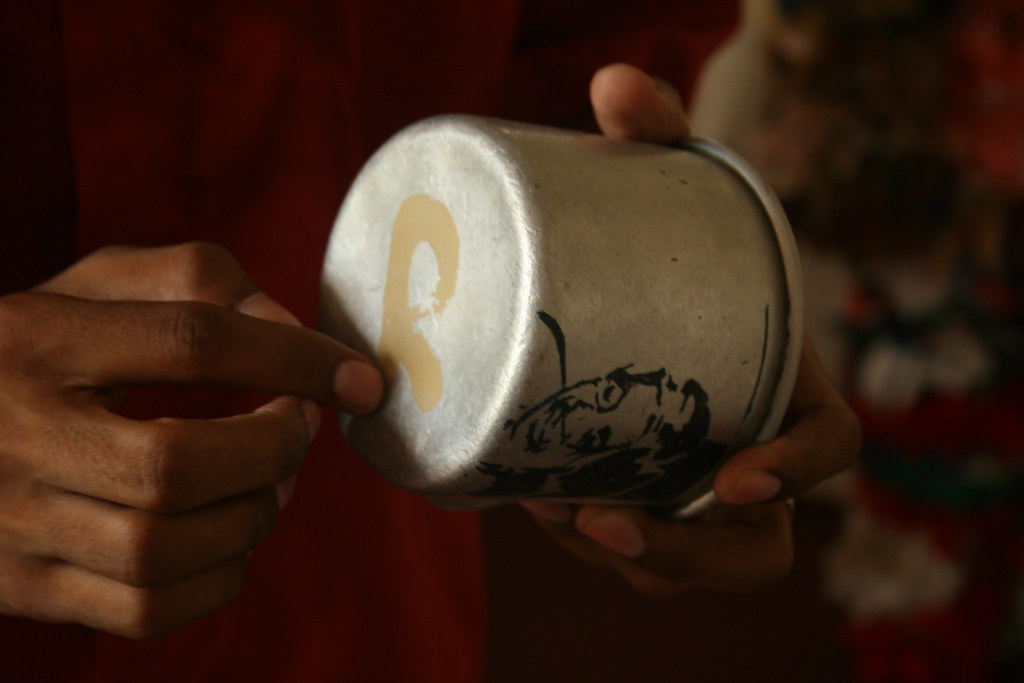
Dhiradj Ramsamoedj holding one of his Adji Gilas cups
September 2009
A few examples of Dhiradj Ramsamoedj’s Adji Gilas cups are placed on the red-oxide-coloured floor of his studio. This is a typical painted floor for a house in Kwatta, west of central Paramaribo, and this looks like a typical cup. We could be in Trinidad or Guyana. He is explaining to me that “adji” means maternal grandmother, and that these aluminium mugs were from her once-active business renting wares for festivities and other events.
Dhiradj points out that the cups still have an “R” written in enamel paint underneath. There are approximately forty of them left. The artist has transferred onto them graphic images derived from early photographs of his grandmother. So this is not just a typical house, or a typical cup: it is Dhiradj’s. We are looking at this work in his grandparents’ home, which has now become his studio or site of investigation. This is a very personal navigation of his experience — his own memory and relationship to family and place.
We are on the inside of his process, and this location is not just a sight to be rendered — not just an image to take to the market, as we see in local art galleries throughout the Caribbean. Most forms of representation in the Caribbean would render the house and the location from a viewpoint across the street, for the touristic or cultural brochures, saying that this is the typical Asian household of this part of the country. It would be a static silenced sign of national diversity or of cultural otherness, accordingly.
But this is Dhiradj’s active site of investigation, of developing personal vocabularies towards sovereign ways of articulating his own lived experiences and stories, from the inside looking out.
I ask him if the work should even leave this site, as the work, the process of minding (caring for) and mining (investigating the symbolic agency of) these intimate elements, this series of actions, resonate within this actual space. They transform the space, which both contains and amplifies their intent. They take on a site-specific implication, and the artist’s actions become differently performative and enabling — not just to me, the viewer, but also to other artists like himself working in places like this everywhere. This is more than just cultural display. This about the artist working his way through what he knows and can understand.
I would like to argue that within this transactional space or moment of exchange we are all transported or altered. So where is Kwatta now within this moment?
Is it in the critical space shaped by his intent, his investigative process, dislodged from narratives of nation, of culture, of cultural display and otherness? Is it an action within the critical space we call the Caribbean, which is just another space where an artist, a creative individual, struggles to understand the world around him- or herself?
After I meet with Dhiradj, he sends me an image by email, in which he arranges the cups — “gilas” — on the internal structural beams of the wooden house, often used as shelves in traditional Caribbean homes. In that single gesture, he weaves together the structural investigations of Remy Jungerman with, of course, Mondrian’s. They are all fair game within his investigative moment.
It is not my intention to create an imbalance, but more to look at the work of Dhiradj as someone whose approach is derived from the current range of influences available to him. This processing and reconfiguring defines the current moment in which many contemporary Surinamese artists are proceeding.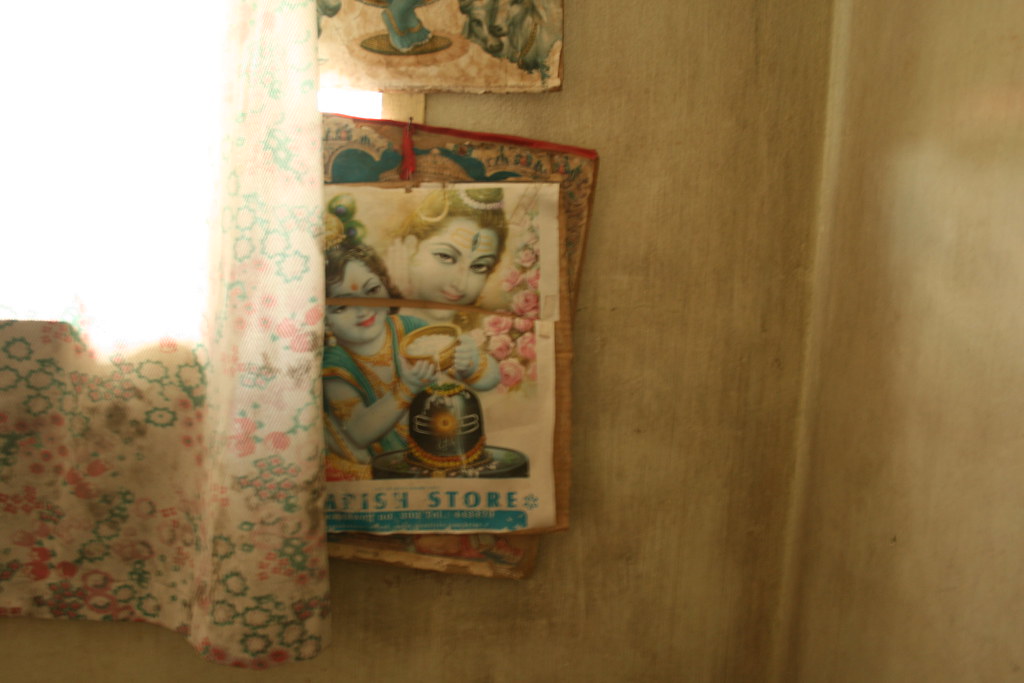
Hindu devotional images in Ramsamoedj's house
Dhiradj Ramsamoedj graduated from the Nola Hatterman Institute in Paramaribo in 2004. His most recent exhibition was Double Feature, together with Kurt Nahar, at the Readytex Art Gallery in August 2009.
Labels: cozier, jungerman, kwatta, project, ramsamoedj
Seen: param@ribo, by Maartje Jaquet
Tuesday, October 13, 2009

Maartje Jaquet is a video artist, photographer, and graphic designer based in Amsterdam. She writes:
My art is about seeing the wonder of daily life in simple things that other people may overlook. It's simple-with-a-twist. I like to share the poetry, wonder and humour of life, being strange enough as it is in itself.
In January 2009, Jaquet visited Suriname to lead a series of oneminute video workshops at AHKCO in collaboration with the Nola Hatterman Art Academy. She documented her time there in a series of photos and videos posted in a Flickr set titled param@ribo.
These still and moving images suggest a fascination with Paramaribo's urban texture: the proliferation of signage, the way people move through public spaces, fragments of buildings or machinery that function almost like pieces of found sculpture.
View Jaquet's Suriname images here.
Labels: maartje jaquet, photography, seen, sign, video
Elsewhere: Sranan Art Xposed
Thursday, October 8, 2009

Paramaribo SPAN contributor Marieke Visser and her collaborators Cassandra Gummels-Relyveld and Priscilla Tosari--supported by the Readytex Art Gallery--have launched a new quarterly e-magazine covering Surinamese art: Sranan Art Xposed. The PDF publication is currently distributed via email, with excerpts posted on the editors' blog. Information on joining the SAX mailing list is available here. The first issue includes a survey of recent art events in Suriname, a short interview with artist Jhunry Udenhout, information on artists' websites, and an article on the recent Wakaman Project.
The editors write: "We seek links, we make connections, we look for news, we spread the news, we zoom in, and we zoom out."
Labels: magazine, sax, sranan art xposed, udenhout, visser
Diary: meeting Pierre Bong A Jan
Thursday, October 1, 2009
By Nicholas Laughlin
26 June, 2009
Paramaribo's northern suburbs are orderly in their sprawl: streets laid out in a careful grid, neighbourhoods separated by drainage canals. The flat terrain with few large landmarks is confusing to visitors--even after several visits to this area I still feel like we're going round in circles--and apparently even taxi drivers can get lost.
Chris and I are fascinated and puzzled by this topography. In most Trinidadian suburbs, you can guess when the land was developed by the predominant architectural style of the houses, which subsequent renovations and remodellings can't completely disguise. But here there is a sense of the temporally haphazard. On a single street we see an old wooden house on stilts--what Chris calls a Guyana house--that could date back to the 1930s or 40s, right next to a 70s bungalow and a spanking new mini-mansion, then an empty lot overgrown with razor grass that to our sensibilities suggests "country".
After several wrong turns on the part of the taxi driver, we finally arrive at Pierre Bong A Jan's house, one of the new-looking ones, facing south onto a broad canal. Bong A Jan waves to us from an upper window, then comes down to escort us past a phalanx of excited big dogs. He is one of the younger artists we've met in Paramaribo, quiet and confident, with a scraggly beard, a necklace of wooden beads, and a series of blue-black tattoos on his left shoulder and upper arm.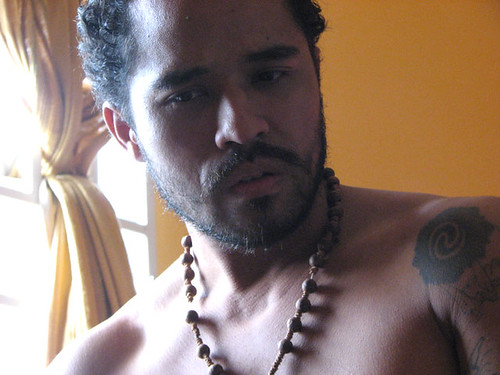
Pierre Bong A Jan in his tattoo studio. Photo by Nicholas Laughlin
The house is neat, airy, tastefully furnished. A large canvas, perhaps six feet wide, is propped against the wall of the front hallway. It depicts a monstrous semi-human creature pouncing on a nubile young woman. The creature's shoulder emerges from the canvas as a piece of wood carving. It makes me think simultaneously of comic book illustration and a stylised Erté poster. The painting is one of a series, Bong A Jan explains, exploring a figure from Surinamese folklore: the bakru, a half-flesh, half-wood forest spirit which does the bidding of its obeahman master.
Bong A Jan takes us up a flight of stairs to a spacious, light-filled loft that runs the full length of the house. This is his main studio, with finished paintings arrayed along one side, pots full of paintbrushes, and an airbrush compressor next to a draftsman's table. He shows us another large painting of a nude young woman, floating against a geometrical background. Both her shoulders are covered with tattoo-like markings, which on closer inspection turn out to be clusters of faya lobi, or ixora flowers--the national flower of Suriname. Beside it is a painting of pairs of eyes glowing out of a deep blackness, like a dream of being lost in the bush at night.
Faya Lobi (2008), by Pierre Bong A Jan. Photo by Marieke Visser
His second studio is a much smaller space, tucked beneath the loft. This is where Bong A Jan works at his day-job: he is a tattoo artist. He shows us his equipment, the padded table where clients lie, and the gun-like tattoo machine. I ask him who did the tattoos on his own shoulder. He smiles. He did them himself, he says--that's why they're on one side only.
Chris asks to see some photos of his other tattoo work. Bong A Jan pulls up a slideshow on his laptop. Some of the images depict standard fare: pseudo-Celtic knots and the like. Others incorporate recognisably Surinamese visual elements, some derived from traditional Maroon carving. One spectacular large tattoo seems to combine Botticelli's Venus with a many-armed Hindu goddess. A few years ago, Bong A Jan tells us, most of his clients asked for standard images and forms you could pick out of any pattern book, but recently there's been more interest in imagery that speaks to a Surinamese identity.
We can see how Bong A Jan's work sets up a creative dialogue between these two media, painting and tattoos, at a meeting-point of conventional "fine" art and bodily adornment, folklore and science fiction, international youth culture and personal self-expression. How might we incorporate this dialogue into the wider conversation of Paramaribo SPAN? Bong A Jan wonders aloud whether he could build a temporary structure, part studio, part installation, and find someone willing to be tattooed in front of an audience--the tattoo as a performance, in multiple senses.
"It won't be me," Chris says, laughing.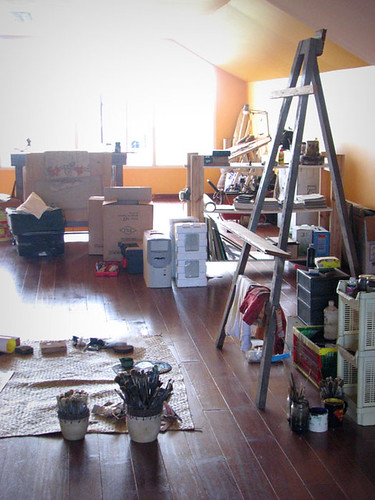
Bong A Jan's painting studio. Photo by Nicholas Laughlin
Labels: bong a jan, diary, folklore, painting, tattoo





